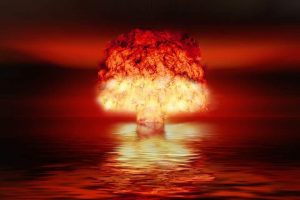What are the bad effects of nuclear weapons?
The nuclear explosions produce both immediate and delayed destructive blast effects, the thermal radiation, and prompt ionizing radiation cause significant destruction within seconds or minutes of a nuclear detonation. The delayed effects of nuclear explosions such as the radioactive fallout and other environmental effects, inflict damage over an extended period ranging from hours to years.
Nuclear weapons
Nuclear weapons are different from conventional weapons because of the vast amounts of explosive energy they can release and the kinds of effects they produce such as high temperatures and radiation.
The initial stage of the blast effects causes the death and the disablement, in this state, it causes the thermal burns and the failure of structures resulting from the blast effects, the fate of humans is closely related to the survival of the buildings around them.
When the nuclear weapon detonates, a fireball occurs with temperatures similar to those at the centre of the Sun where approximately 85 % of the explosive energy produces the air blast (and shock) and the thermal radiation (heat).
The remaining 15 % of the energy emitted is released as initial radiation that produced within the first minute and residual (or delayed) radiation that emitted over a period of time, some of which can be in the form of local fallout.
The energy of a nuclear explosion is released in the form of a blast wave, the thermal radiation (heat) and the nuclear radiation, and the distribution of energy in these three forms depends on the yield of the weapon.
The nuclear weapons in the kiloton range cause energy that is divided in various forms, roughly as 50% blast, 35% thermal and 15% nuclear radiation, Each one of these forms causes devastation on a scale that is unimaginable.
the light from the explosion (which is many times hotter than the sun) is so bright that it will immediately and permanently blind every living thing, Some deaths will occur hundreds and even thousands of miles away as low levels of ionizing radiation are capable of causing the full spectrum of health effects.
The nuclear detonation creates a severe environment including blast, the thermal pulse, the neutrons, x-rays and gamma-rays, the radiation, the electromagnetic pulse (EMP), and the ionization of the upper atmosphere.
Tens of millions of people would die, the global temperatures would crash and most of the world would be unable to grow crops for more than five years after the nuclear explosions.
The nuclear explosions will affect the ozone layer which protects the surface of the Earth from harmful ultraviolet radiation, it would be depleted by 40% over many inhabited areas and up to 70% at the poles.
The effects of exposure to high levels of radioactive include the fall-out of hair, the bleeding from the mouth and gums, internal bleeding, gangrenous ulcers, vomiting, the fever, the delirium and the terminal coma, there is no effective treatment and the death follows in a matter of days.
While there is an increased chance of at least short term survival, the death rate remains high, the pregnant women are likely to miscarry or give birth to babies with a range of disabilities, Healing from injuries is often slow, leaving distinctive scar tissue, The damage to the immune system is probable.
Nuclear submarines (Nuclear Powered Ships) advantages and disadvantages
Nuclear fission & Atomic Bomb harmful effects
The effect of the military explosions on the human and the environment
Intercontinental missiles types, advantages and disadvantages
Rockets and Missiles types, structure, uses, advantages, disadvantages & How rockets work




